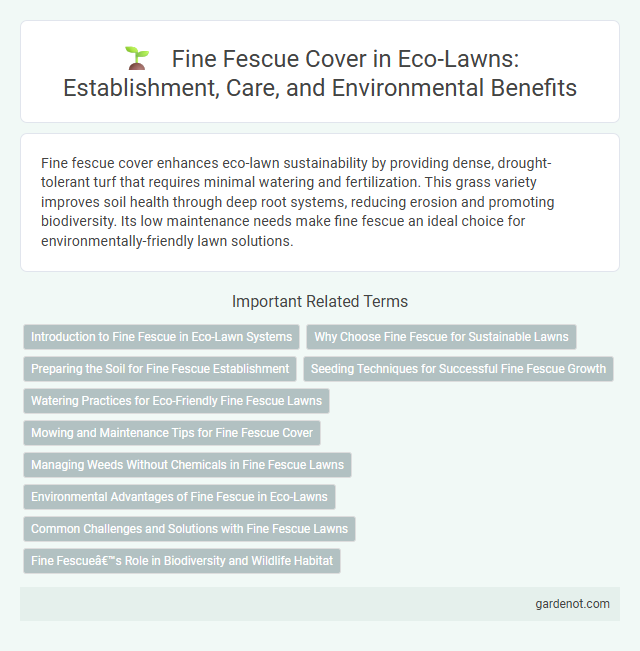Fine fescue cover enhances eco-lawn sustainability by providing dense, drought-tolerant turf that requires minimal watering and fertilization. This grass variety improves soil health through deep root systems, reducing erosion and promoting biodiversity. Its low maintenance needs make fine fescue an ideal choice for environmentally-friendly lawn solutions.
Introduction to Fine Fescue in Eco-Lawn Systems
Fine fescue, known for its drought tolerance and shade adaptability, is an ideal species for eco-lawn systems promoting sustainable landscaping. Its fine-textured blades create a dense, low-maintenance turf that requires less water and fertilizer than traditional lawn grasses. Incorporating fine fescue in eco-lawn mixtures supports biodiversity while reducing environmental impact through decreased resource consumption.
Why Choose Fine Fescue for Sustainable Lawns
Fine fescue is ideal for sustainable lawns due to its low water requirements and superior drought tolerance, reducing the need for irrigation. Its shade tolerance and ability to thrive in poor soil conditions minimize lawn maintenance and chemical inputs. Fine fescue's deep root system enhances soil health and carbon sequestration, contributing to eco-friendly lawn care.
Preparing the Soil for Fine Fescue Establishment
Preparing the soil for fine fescue establishment involves thorough soil testing to determine pH and nutrient levels, aiming for a slightly acidic to neutral pH between 6.0 and 7.0. Organic matter should be incorporated to improve soil structure, drainage, and moisture retention, promoting optimal root development for fine fescue. Proper tilling and removal of debris create a smooth seedbed, ensuring uniform seed-to-soil contact essential for successful germination and growth.
Seeding Techniques for Successful Fine Fescue Growth
Fine fescue thrives best when seeded using precise techniques such as planting in early fall to maximize soil moisture and temperature conditions optimal for germination. Employing a shallow seeding depth of about 1/8 to 1/4 inch and ensuring firm soil contact enhances seed-to-soil contact, crucial for fine fescue root establishment. Consistent watering schedules that keep the soil evenly moist without waterlogging promote uniform seedling emergence and robust turf development.
Watering Practices for Eco-Friendly Fine Fescue Lawns
Fine fescue thrives with minimal watering, requiring only about 1 inch of water per week, making it ideal for eco-friendly lawns. Deep, infrequent watering encourages strong root development and reduces water waste. Avoid frequent shallow watering to maintain drought tolerance and optimal turf health.
Mowing and Maintenance Tips for Fine Fescue Cover
Fine fescue cover thrives with infrequent mowing, ideally set between 2.5 to 3.5 inches to maintain its dense, lush appearance while minimizing stress. Regularly removing debris and avoiding excessive nitrogen fertilization help preserve turf health and prevent invasive weeds. Proper watering practices, such as deep and infrequent irrigation, promote deep root growth and drought resistance in fine fescue lawns.
Managing Weeds Without Chemicals in Fine Fescue Lawns
Fine fescue lawns provide a dense, low-maintenance turf that naturally suppresses weed growth due to their fine texture and shade tolerance. Managing weeds without chemicals in fine fescue involves practices like regular mowing at the recommended height of 2 to 3 inches, overseeding bare spots, and maintaining healthy soil fertility through organic amendments. Proper irrigation timing and avoiding overwatering further discourage weed seed germination, enhancing the lawn's natural weed resilience.
Environmental Advantages of Fine Fescue in Eco-Lawns
Fine fescue cover in eco-lawns offers significant environmental advantages, including exceptional drought tolerance and low nutrient requirements, which reduce water usage and minimize the need for chemical fertilizers. This grass species enhances soil health by improving organic matter and supporting beneficial microbial activity, promoting sustainable lawn ecosystems. Its dense growth habit effectively suppresses weeds, decreasing the reliance on herbicides and contributing to a healthier environment.
Common Challenges and Solutions with Fine Fescue Lawns
Fine fescue lawns often face challenges such as shade intolerance, susceptibility to drought stress, and slow recovery from wear. Proper soil aeration and targeted irrigation strategies improve water retention and promote deeper root growth, addressing drought issues effectively. Incorporating overseeding with compatible grass species enhances lawn density and resilience while managing shade-related thinning in fine fescue coverage.
Fine Fescue’s Role in Biodiversity and Wildlife Habitat
Fine fescue cover supports biodiversity by providing a habitat rich in native insects, pollinators, and small wildlife, enhancing local ecosystems. Its dense, low-maintenance growth reduces the need for chemical fertilizers and pesticides, promoting healthier soil and water quality. Fine fescue's adaptability to various soil types and shade conditions makes it a crucial plant for sustainable landscapes and wildlife corridors.
Fine fescue cover Infographic

 gardenot.com
gardenot.com